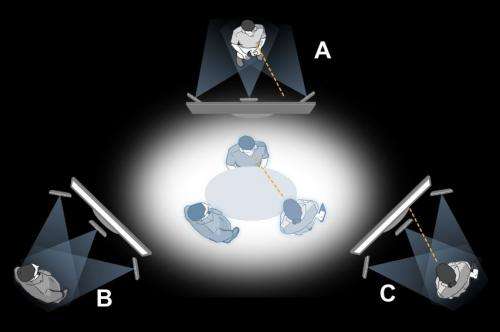Fully distributed 3-way videoconferencing that preserves the relative seating geometry as a face-to-face meeting. Credit: Microsoft Research
(Phys.org) —The buzz around new happenings at Microsoft stems from two job ads posted last week. The ads reveal that Microsoft means serious business about working on telepresence technology that will enable body doubles, in the next wave of business conference calls. Microsoft seeks two software development engineers, and the job ad wordings reveal Microsoft's research goals: Microsoft plans to deliver a telepresence technology system that can depict a person on the other end of a business conversation.
The ads indicate that these representations of remote conference attendees are on Microsoft's virtual conferencing technology agenda. One of the two ads posted was for a Software Development Engineer, Principal. The ad asked: "Want to be responsible for redefining how people telecommute, communicate and work? Not just getting them connected, but truly bringing them together with cutting edge software and hardware."
Microsoft said it is now developing the hardware and software necessary to have a realistic physical body-double or proxy taking part in a remote meeting.
Microsoft said the remote worker will have a "true seat at the table, the ability to look around the room, turn to a colleague and have a side conversation. Longer-term, this same platform will enable high-definition communication scenarios for consumers over Skype."
That wording indicates the new technology, once ready for release, would take videoconferencing beyond talking heads and into the realm of communications capturing dynamic exchanges of multiple conversations. The frequently heard reservation by business managers about tele-meetings has been how in-person meetings generate more substantive idea-swaps and better collaborations. Should the technology enable a true seat at the table, as described by Microsoft, then businesses may be far more amenable to teleconferencing.
Microsoft's ad called on experienced developers (C/C++/C#). The leader is expected to not only lead the project but also contribute to the architecture and hands-on coding. The ad called for expertise in "any of the following," WinRT, Win 8, mobile applications, communication applications, distributed systems, Lync/Skype, video & audio codecs; image/video processing, computer vision, embedded systems, firmware, sensing, robotics, control systems, and hardware products.
The other job listing was similarly for a software development engineer, and this ad referred to a "Microsoft Mesa project." According to the ad, "The Microsoft Mesa project is creating immersive telepresence products that will change the way remote workers experience and are experienced in meetings."
The ad mentioned how Microsoft builds on technologies like Lync and Skype and also "emerging" ones like Windows 8 and Surface, with the additionof "unique Mesa specific technologies (like video processing)." According to the ad, experience with "XAML, MVVM and property models is a plus."
More information: Viewport: A Fully Distributed Immersive Teleconferencing System with Infrared Dot Pattern: research.microsoft.com/pubs/16 … 5/msr_tr_2012-60.pdf
© 2013 Phys.org






















